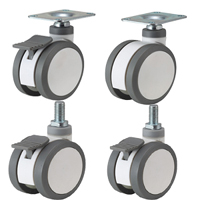Hospital bed wheels might seem like a small component in the grand scheme of healthcare equipment, but their importance cannot be overstated. They are central to the functionality, safety, and efficiency of both patient care and hospital operations. This comprehensive analysis explores why hospital bed wheels are crucial and how they impact various aspects of healthcare delivery.
1. Enhancing Mobility and Accessibility
One of the primary functions of hospital bed wheels is to facilitate easy movement. This is critical in a hospital setting where quick and efficient relocation of beds can significantly affect patient care.
Ease of Transportation: Hospital beds are often moved between different areas, such as from the patient’s room to the operating theater or from one department to another. Wheels make this transportation possible without the need for heavy lifting or physical strain on staff, reducing the risk of injury.
Patient Transfer: For patients with limited mobility or those who are bedridden, smooth and efficient movement is essential. Bed wheels allow caregivers to reposition beds easily, ensuring that patients can be moved with minimal discomfort. This is particularly important for transferring patients between different types of medical equipment or for repositioning them within their rooms.
Facility Layout and Space Management: Hospitals must be designed to accommodate various types of medical equipment and to facilitate patient flow. Bed wheels enable flexible arrangement of beds, which can be adjusted according to the needs of the facility. This adaptability helps in optimizing space usage and in responding to fluctuating patient volumes.
2. Ensuring Safety and Stability
Safety is a paramount concern in healthcare settings, and hospital bed wheels play a key role in maintaining a safe environment for both patients and staff.
Locking Mechanisms: Most hospital bed wheels are equipped with locking mechanisms to prevent unintended movement. This feature ensures that beds remain stationary when needed, such as during patient examinations or procedures, thereby reducing the risk of accidents or falls.
Stability on Various Surfaces: Hospital bed wheels are designed to provide stability on different types of flooring, including smooth vinyl, tile, and even uneven surfaces. This adaptability minimizes the risk of bed instability, which could potentially lead to patient falls or injuries.
Shock Absorption: Some wheels are engineered to absorb shocks and vibrations, which helps in reducing the impact of movement on patients. This is particularly beneficial for patients with conditions that require minimal jostling, such as those recovering from surgery or experiencing severe pain.



3. Improving Caregiver Efficiency and Comfort
The design and functionality of hospital bed wheels have a direct impact on the efficiency and comfort of caregivers.
Reduced Physical Strain: Maneuvering beds with wheels is less physically demanding than lifting or dragging them. This reduction in physical strain helps to prevent musculoskeletal injuries among hospital staff, allowing them to perform their duties more efficiently and with greater comfort.
Streamlined Workflow: The ability to easily move and reposition beds contributes to a more organized and efficient workflow in hospitals. Caregivers can quickly adapt to changing patient needs and respond promptly to emergencies without being hindered by cumbersome equipment.
Enhanced Precision: Swivel wheels, which allow for 360-degree movement, provide caregivers with greater precision when positioning beds. This precise control helps in placing beds accurately in tight spaces or aligning them properly for medical procedures.
4. Contributing to Infection Control
Infection control is a critical aspect of hospital management, and hospital bed wheels play a role in maintaining a clean and hygienic environment.
Ease of Cleaning: Wheels that are designed to be smooth and non-porous are easier to clean and disinfect. This feature helps in maintaining high standards of hygiene, reducing the risk of cross-contamination and infection.
Minimized Dirt and Debris: Wheels that roll smoothly and are well-maintained are less likely to collect dirt and debris. This cleanliness is important in preventing the spread of infections within the hospital environment.
5. Supporting Patient Comfort and Care
Patient comfort is a central concern in healthcare, and the functionality of hospital bed wheels can impact this aspect in several ways.
Smooth Operation: Wheels designed for quiet and smooth operation contribute to a more serene environment, which can help in reducing patient anxiety and discomfort. The ability to move beds silently and effortlessly is particularly important for patients who are sensitive to noise or movement.
Adjustable Positioning: The ability to easily reposition beds allows for better patient care and comfort. For instance, adjusting the angle of the bed or changing its location can help in meeting specific medical needs or in accommodating patient preferences.
6. Supporting Emergency Situations
In emergency situations, the functionality of hospital bed wheels becomes even more critical.
Rapid Response: In case of an emergency, such as a sudden change in a patient’s condition or the need for immediate evacuation, wheels enable quick and efficient movement of beds. This capability is essential for ensuring that patients receive timely care and can be moved swiftly to safety or treatment areas.
Versatility: The versatility of bed wheels allows for rapid adjustments to accommodate various emergency scenarios, from repositioning beds to navigate around obstacles or to adapt to different treatment environments.
Hospital bed wheels are far more than simple components; they are essential to the effective functioning of healthcare environments. Their role in enhancing mobility, ensuring safety, improving caregiver efficiency, supporting infection control, and contributing to patient comfort underscores their importance in modern healthcare settings. By providing stability, ease of movement, and adaptability, hospital bed wheels contribute to a more efficient and safe healthcare experience for both patients and medical staff. Their design and functionality reflect a broader commitment to optimizing patient care and ensuring the smooth operation of healthcare facilities.
www.casterwheelsco.com ; sales@casterwheelsco.com
wechat/whatsapp: +0086- 137 3645 4395


Comments
Post a Comment